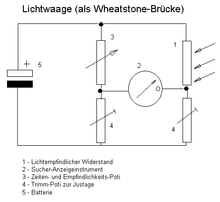Light balance
The light balance is a term from photo technology . In older cameras, the light balance is the electrical measuring device for analog exposure measurement.
Electrotechnically , the light balance is a special application of the resistance bridge: a differential voltage is formed from four resistors in a circuit and displayed in the viewfinder of the camera. Either the voltage value should be zero or be given a defined, small dimension that aligns the pointer in the viewfinder with a target mark. With the photographic parameters with this display center position, the film will be correctly exposed.
The measurement is influenced by the following factors:
- the amount of incident light,
- the reduction of light through a reduced working aperture (with open aperture measurement),
- the shutter speed as well
- the film speed.
Electrical components of this measurement are:
- the light measuring resistor,
- a resistor (potentiometer, rotary resistance), on which the light sensitivity of the film used is set, which mostly superimposes the set time value or together leads to the potentiometer turning, and
- at least two potentiometers, which usually allow the service technician to adjust the measuring device in the bottom of the camera.
The concept of the light balance is derived from the Wheatstone resistance measuring bridge , which is often used in electrical engineering and electronics for control and regulation purposes.
